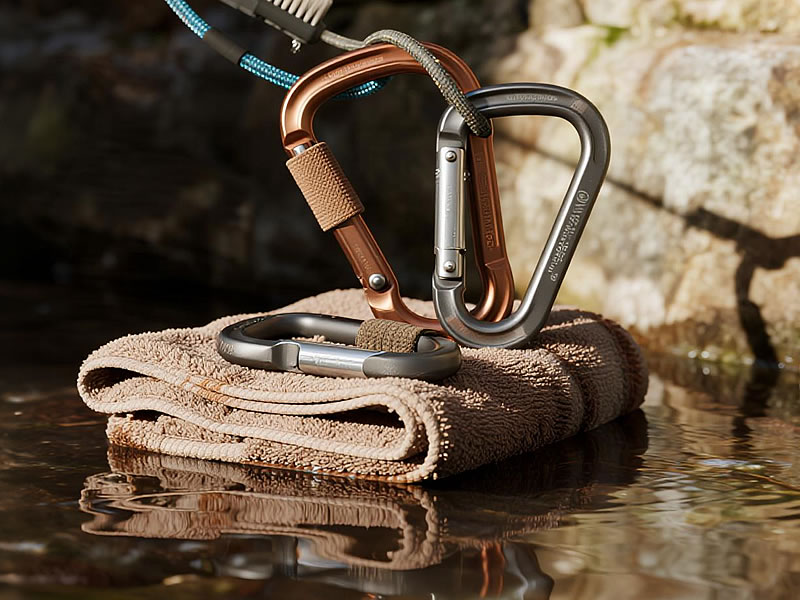How to clean and maintain climbing swivel carabiners
Swivel carabiners are essential for preventing rope twists and enabling smooth movement during climbs, but their complex mechanisms demand meticulous care. Neglecting maintenance risks corrosion, jamming, gate failure, or catastrophic breakage. Follow this expert protocol to ensure your swivel biners remain reliable for years.

Why Special Care Matters
Swivels feature moving parts prone to trapping dirt, sand, salt, or moisture. Contaminants accelerate wear, cause binding under load, and compromise locking mechanisms. Regular maintenance isn’t optional—it’s critical for safety.
Step 1: Post-Climb Cleaning
- Rinse Immediately: Flush with lukewarm water after exposure to saltwater, mud, or grit. Use a soft-bristle toothbrush to dislodge debris from the swivel joint and gate spring.
- Avoid Soaking: Submerging can force particles deeper into pivots. Never use pressurized water.
Step 2: Deep Cleaning (Every 2-3 Months)
- Disassemble (If Possible): Check manufacturer guidelines. Some swivels (e.g., Petzl Ball-Lock) allow controlled disassembly.
- Gentle Bath: Soak briefly in warm water + mild dish soap. Scrub with a soft brush, focusing on hinge areas.
- Ultrasonic Cleaner (Optional): Ideal for steel carabiners with stubborn grime. Never use on anodized aluminum.
- Rinse Thoroughly: Ensure no soap residue remains.
Step 3: Drying & Corrosion Prevention
- Pat Dry: Use lint-free cloths. Compressed air (<30 PSI) can blow moisture from swivels.
- Air Dry: Leave unlocked in a warm, dry area for 24+ hours.
- Steel Care: Apply anti-corrosion spray (e.g., WD-40 Corrosion Inhibitor) externally only if used near saltwater. Wipe excess.
Step 4: Lubrication (Sparingly!)
- Use ONLY Dry Lubricants: Teflon-based sprays (e.g., Tri-Flow) or graphite powder. Oil attracts grit.
- Apply Micro-Drops: Add lubricant to swivel pivots only if rotation feels gritty. Spin the joint to distribute.
- Wipe Excess: Residual lubricant traps dirt.
Step 5: Inspection: The 5-Point Check (Do Before EVERY Climb)
- Body: Cracks, deep gouges, or deformation? Retire if found.
- Gate: Opens/closes smoothly? No stickiness or play.
- Locking Mechanism: Screwgates thread fully; auto-locks engage audibly.
- Swivel: Rotates freely under finger pressure without grinding.
- Pivots/Pins: Corrosion (white powder on aluminum, rust on steel)?
Critical Storage Rules
- Hang or store loose in a dry, cool place away from UV rays.
- Never store clipped to metal loops (causes galvanic corrosion).
- Avoid contact with acids, solvents, or bleach.
When to Retire Your Swivel Carabiner
Replace immediately if:
- Dropped >10m onto hard surfaces
- Exposed to extreme heat (e.g., fire)
- Shows cracks, gate wobble, or swivel resistance
- Used in a severe fall (even if visually intact)
- Has >5 years of intensive use
Pro Tip: Keep a maintenance log! Track cleaning dates and inspections.
Common Pitfalls to Avoid
- Using silicone grease or WD-40 as lubricant (attracts grime)
- Boiling carabiners (weakens metal)
- Ignoring "gritty" swivel feel
- Storing wet or dirty
Your swivel carabiner’s lifespan depends on diligent care. Invest 10 minutes after each climb to clean and inspect—this simple habit prevents equipment failure and safeguards your life. When in doubt, retire gear early; your safety is worth more than any piece of hardware.






